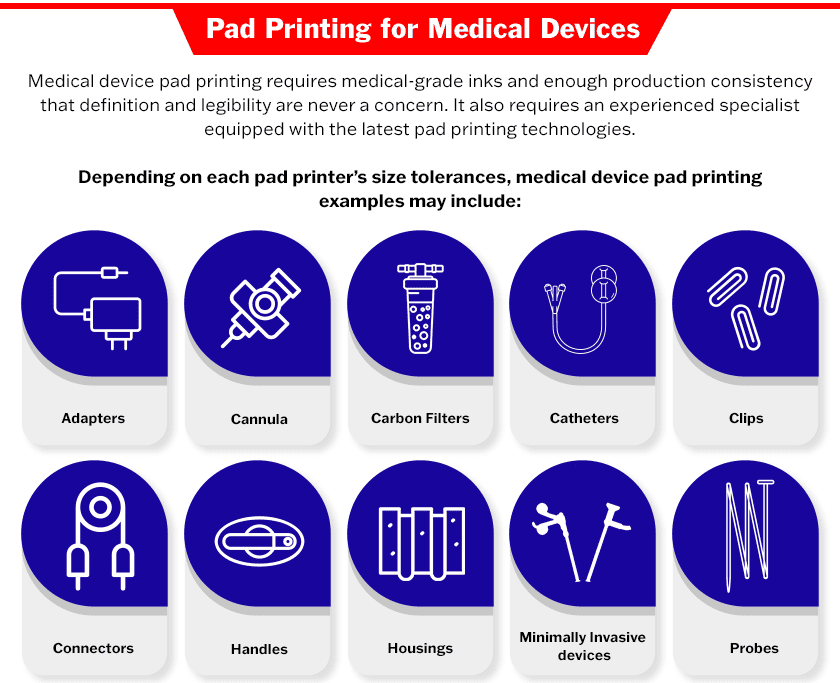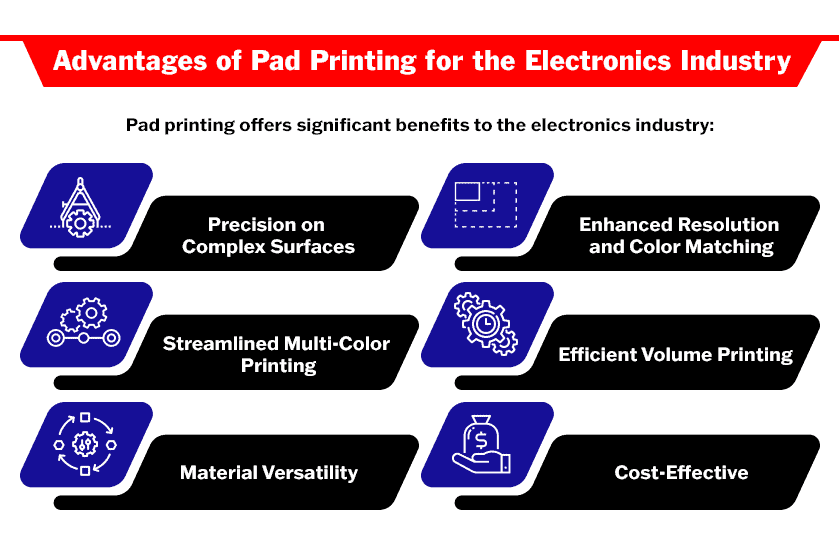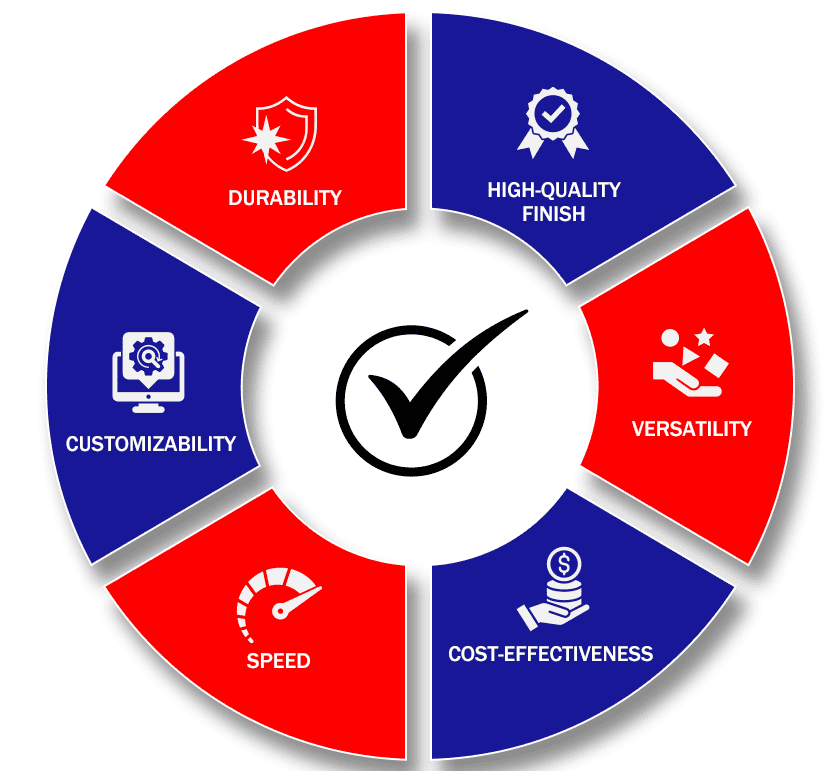Pad Printing for Medical Devices
Leave a CommentMedical device manufacturers depend on an accurate, versatile method for printing onto a wide range of objects and materials. Maintaining maximum print consistency on oddly shaped or textured items presents challenges that are best overcome with pad printing.
In pad printing, technicians achieve high-quality image transfers using a flexible printing pad. Learn more about this versatile process and how it benefits medical device manufacturing.
What Is Pad Printing?
Pad printing is an offset image transfer method for transferring a 2D image onto a 3D part. It’s effective even on irregularly shaped materials and textured surfaces. A pad printing machine requires only three main components to function:
- An etched plate, called a cliché, which contains the desired graphic
- An ink cup, which slides across or “doctors” the etched plate, leaving a thin layer of ink conforming to the exact contours of the etched design
- A printing pad made of a semi-soft silicone material that presses into the plate, transferring the ink to the pad, and then presses the ink onto the intended surface
This ink transfer method may be performed by a range of pad printing machines suited for different image sizes and numbers of colors. Pad printing works on a variety of materials, making it useful for general industrial, automotive, promotional, garment, watchmaking, home appliance, medical device, and other manufacturing sectors.
Pad Printing for Medical Devices
Medical device pad printing requires medical-grade inks and enough production consistency that definition and legibility are never a concern. It also requires an experienced specialist equipped with the latest pad printing technologies. Depending on each pad printer’s size tolerances, medical device pad printing examples may include:
Pad Printing for Medical Devices
- Adapters
- Cannula
- Carbon filters
- Catheters
- Clips
- Connectors
- Handles
- Housings
- Minimally invasive devices
- Probes
- Shafts
- Syringes
- Tubing
- Valves
- Vascular devices
Because pad printing services are usually part of a more comprehensive manufacturing process, they’re subject to many of the same quality controls and tolerance windows. As a result, pad printing providers must be capable of meeting the stringent demands of original equipment manufacturers (OEMs) throughout the entire product development process.
In the medical field, pad printing facilitates high-quality image/text transfer for a range of devices that would otherwise be difficult or impossible to print on. Using pad printing technology, medical device manufacturers can expect the following benefits:
- Compatibility with textured or curved surfaces, irregular shapes, and complex substrates
- Class VI Medical Grade inks
- Enhanced versatility
- Product topography
- Suitable across a variety of industries
- Time-proven processes
Medical Device Pad Printing From Teca-Print
Teca-Print USA develops the most sophisticated pad printing technologies, backed by automated processes and quality controls designed to maintain product consistency even at peak printing efficiency. Our advanced pad printers enable a long list of industries to print their logos and other graphics on objects of almost any size and shape. With over 30 years of experience, we’ve been at the forefront of innovative pad printing technologies, including pad printer research, development, and manufacturing.
To learn more about medical device pad printing or how our services can support your needs, contact Teca-Print USA.
Pad Printing for the Electronics Industry
Leave a CommentThe electronics industry uses pad printing to transfer text and images onto 3D items like electric circuits, keypads, semiconductors, fuses, housings, and more. The process is useful for labeling parts, making them easy to identify and track during production. Learn more about the steps to pad printing electronics, as well as the benefits and applications of this process.
Process of Pad Printing for the Electronics Industry
Pad printing involves the transfer of a two-dimensional single or multi-color image onto a three-dimensional component, producing quick, precise results. Here are the primary steps to pad printing electronics.
Pad Printing for the Electronics
Industry
Prepare Artwork
The design is prepared in its digital format—adjustments are made to line thickness, color, and intensity. These tweaks are essential in achieving optimal printing results and are done in consideration of factors like the electronic component’s material, texture, and size.
Prepare Printing Plates
The artwork is then etched onto a printing plate made of metal or polymer. The etched plate’s quality significantly influences the printed image’s accuracy, sharpness, and lasting impact. The plate will enable precise replication of every intricate detail onto the final product.
Ink Preparation
Choosing the right ink is crucial for successful pad printing. The ink is carefully matched to the material and color needs of the electronic component. Factors like ink thickness, drying time, adhesion, and color consistency are considered to ensure the best pad printing results.
Affixing the Component
Next, the component is positioned onto a fixture or jig, securing it firmly during printing. This adaptable fixture accommodates diverse component shapes and sizes, making the most of the available printing surface.
Ink Transfer
The silicone pad is pressed onto the etched, inked plate, transferring the ink onto the pad’s surface. Then the pad is carefully pressed onto the component to transfer the ink to that surface.
Drying/Curing
To ensure the longevity of the printed image, the ink is either air-dried or cured using methods such as heat or UV light. The curing method depends on the ink type and the material of the electronic component.
Inspection and Quality Control
A thorough inspection is conducted on the printed component to evaluate factors like print quality and alignment. If any defects or inconsistencies are found, they are promptly corrected to ensure the final products meet all required standards.
Packaging and Shipping
Once the components pass quality control, they are packaged and prepared for shipment. These printed components are sent to customers for assembly or further processing.
Advantages of Pad Printing for the Electronics Industry
Pad printing offers significant benefits to the electronics industry:
- Precision on Complex Surfaces: This method uses a flexible silicone pad that conforms to irregular shapes, producing accurate prints.
- Enhanced Resolution and Color Matching: Pad printing ensures high-resolution prints with precise color reproduction.
- Streamlined Multi-Color Printing: Pad printing’s ability to incorporate multiple colors and layers in a single pass simplifies production.
- Efficient Volume Printing: Its speed and efficiency are perfect for handling large printing volumes in electronics manufacturing.
- Material Versatility: Pad printing works seamlessly with various materials and substrates in the electronics sector, such as plastics, metals, and glass.
- Cost-Effective: The pad printing machine is quick, easy to use, and offers a cost-effective solution for in-house pad printing processes.
Applications of Pad Printing in the Electronics Industry
- Keypad Printing: Pad printing is commonly used to add designs and information to electronic keypads on devices like calculators, remote controls, and phones.
- Printed Circuit Board Printing: Pad printing also labels printed circuit boards, indicating where different electronic parts should go.
- LED Printing: Letters, numbers, and graphics can be pad printed on the surfaces of LEDs and similar components.
- Membrane Switch Printing: Pad printing helps label membrane switches—thin, flexible electrical switches that control electronic devices.
- Capacitive Touch Panel Printing: This method creates custom designs on capacitive touch panels, which are important for devices like smartphones and tablets.
- Speaker Grille Printing: Pad printing is useful for adding logos and designs on the speaker grilles of electronics like laptops, smartphones, and tablets.
- Battery Printing: This printing technique adds codes, logos, and more to battery exteriors.
Choosing Teca-Print for Pad Printing in the Electronics Industry
Teca-Print designs, manufactures, and delivers cutting-edge pad printing machinery, inks, and other essential supplies. Our pad printing solutions cover everything from state-of-the-art equipment to premium inks and valuable additives. We also offer in-house contract pad printing services, providing an all-in-one solution for our customers.
At Teca-Print, we’re experts in designing custom pad printing solutions that cater to the electronics industry’s complex needs. Our skilled graphic designers work closely with clients’ design teams to create graphics tailored for pad printing.
Contact us today to start your solution.
Printing On Cosmetic Bottles Using Pad Printing
Leave a CommentDecorating and branding your cosmetic bottles can make your brand stand out from the crowd. With a good printing service, you can differentiate your product, make the unique value proposition of each item clear, and comply with federal or international labeling regulations. Pad printing is a high-quality, versatile printing method that can transfer ink-based text and designs right onto the bottle. Learn more about the pad printing process, the benefits it offers, and some of the most advantageous use cases in the industry.
Steps to Pad Printing on Cosmetic Bottles
Cosmetic bottle printing is a five-step process. Your pad printing provider can manage this entire process at low or high volumes to fulfill demand.
- Choosing the Ink: First, match your printing ink with the bottle’s material. Certain inks will work best with glass, plastic, and metal surfaces. You might also select a specialized ink that offers additional benefits.
- Preparing Artwork: Next, your manufacturer can adjust the size, orientation, placement, and complexity of the digital design to facilitate an accurate, high-quality printing process.
- Preparing the Plate: Once the artwork or text layout is finalized, your provider can create the plate, which involves these two steps:
- Etching: The design is etched onto a plate by using etching chemicals or a laser.
- Inking: To start printing, a doctor blade applies a coating of ink onto the plate. Any excess ink is wiped away to create a clean print.
- Ink Transfer: To create the ink print, a pad is pressed over the etched, inked plate, transferring the ink to the pad. Then the pad is pressed against the bottle to deposit the ink onto that surface.
- Curing the Print: Most pad prints must be UV light cured to dry and adhere permanently to the bottle surface.
Advantages of Pad Printing on Cosmetic Bottles
Pad printing offers several advantages over other industrial printing processes for cosmetic bottles.
Printing On Cosmetic Bottles
Using Pad Printing
High-Quality Finish
Pad printing creates extremely precise images that capture every detail of the etched design. The final image is colorful, long-lasting, and clear. The results are also highly reproducible, so every bottle looks virtually identical.
Versatility
Cosmetic bottle printing works with a wide range of sizes, shapes, and materials. Pad printing can be used on smooth or curved surfaces, textured planes, and plastic, glass, or metal bottles.
Cost-Effectiveness
Pad printing does not require expensive equipment or specialized labor. It is a cost-effective solution for both low and high volumes of orders, which makes it accessible for both small businesses and large industrial enterprises.
Speed
Pad printing setups can quickly cycle through different bottles to print large volumes on short timelines.
Customizability
Pad-printed designs start with a software file. Designers can change the colors, adjust the size, and add custom graphics to the design, which is then reproduced on an etched pad. Each design or physical pad can be customized to suit the size and other parameters of the product bottle.
Durability
Pad-printed graphics are long-lasting. Once the ink cures, it permanently adheres to the bottle surface and can withstand sunlight, wear, and physical abrasion from scratches, drops, and other scuffs. This results in a package that looks great on the shelf and the entire time the consumer uses it.
Applications of Pad Printing on Cosmetic Bottles
Companies can use pad printing to display virtually any information on their bottles, whether it’s promotional information about your brand or specific product use instructions. Cosmetic bottles need to hold a lot of information, and that includes the following:
- Branding: Companies can add full-color logos and branding to their bottles to establish their brand identity and make their bottles stand out.
- Labeling: Pad printed labeling provides lots of information and can be added to glass or plastic bottles of any size. These labels resist fading, wear, and smudging, providing long-term value to the consumer.
- Customization: Pad printing is entirely customizable. It can work with virtually any design and color palette. It can also transfer the designs onto a wide range of surface types.
- Compliance: Pad printing techniques can ensure bottles display required information like expiration and manufacturing dates, ingredients, and more.
Pad Printing on Cosmetic Bottles From Teca-Print
Since 1989, Teca-Print has provided premium pad printing machines and consumables to a global customer base. We provide custom pad printing services for cosmetic bottles so that your brand can stand out. Contact us today to learn more about our capabilities.



